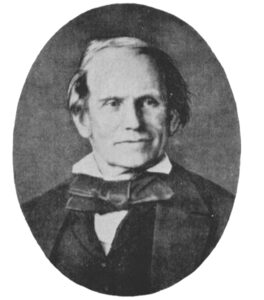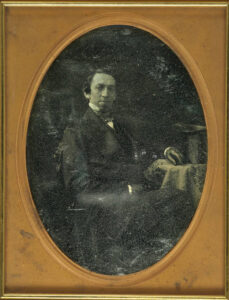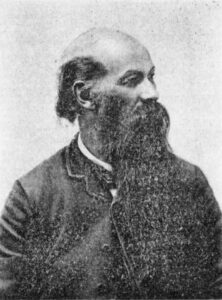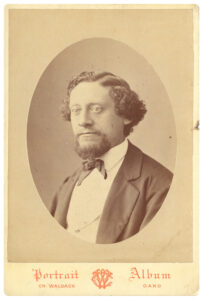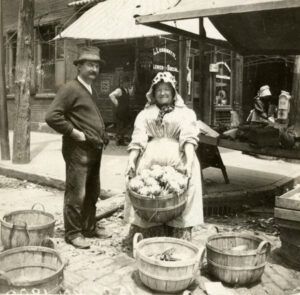The Big Picture Home About Distribution Media Room Education
“Capturing Life” (1839-1869)
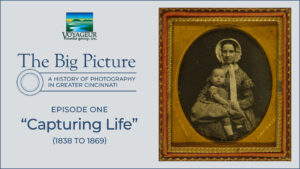 “Capturing Life” (1839-1869) is the first episode in The Big Picture: A History of Photography in Greater Cincinnati, a three-part documentary series that examines the role of photography in the region’s economic, social and cultural development from 1839 to 1939. Greater Cincinnati was a major center for the development of American photography. However, few know about the contributions made by regional scientists and daguerreotypists to the growth of photography from a technological invention into a new artistic medium and thriving business from 1839 to 1869.
“Capturing Life” (1839-1869) is the first episode in The Big Picture: A History of Photography in Greater Cincinnati, a three-part documentary series that examines the role of photography in the region’s economic, social and cultural development from 1839 to 1939. Greater Cincinnati was a major center for the development of American photography. However, few know about the contributions made by regional scientists and daguerreotypists to the growth of photography from a technological invention into a new artistic medium and thriving business from 1839 to 1869.
“Capturing Life” presents the remarkable careers of such photography pioneers as John Locke, Ezekiel Hawkins, James P. Ball, Charles Fontayne, William Porter, Charles and Mary Waldack, and John Wildman Winder. The one-hour documentary explores the impact of photography on key historical events, including immigration, western expansion, the abolitionist movement, the Underground Railroad, the Civil War, and post-war industrialization. “Capturing Life” also reveals how photography helped to shape the identity of individuals, families and communities as the region rose from modest river towns into a major commercial center in America’s heartland.
This companion website contains resources and educational materials that broaden and deepen subjects presented in the documentary. The About page contains materials used to produce the documentary, including profiles of featured photographers, the script, bibliography and an illustration list. The Distribution page has information about ways to watch the documentary. The Media Room holds press releases and promotional images. And, the Education page has lesson plans and images teachers and students may use to enhance classroom use of the program.
Project Materials
Documentary script (PDF)
Archive list (PDF)
Bibliography (PDF)
Production credits (PDF)
Photographer Profiles
Voyageur has written profiles of five photographers featured in the documentary “Capturing Life” (1839-1869). The profiles are based on information compiled during project research including archival links, bibliographies, documents, photographs, and stories that are not presented in the program. The profiles are provided as free PDF documents for research and education purposes.
Dr. John Locke (pdf) Dr. John Locke was a professor of medicine, botany, chemistry and geology who also experimented with photogenic drawings, an early form of photography invented by William Henry Fox Talbot. In the spring of 1839, Locke displayed a series of photogenic drawings in the bookstore of Alexander Flash on Third Street in Cincinnati. These were the first photographs ever exhibited in America. Photo: Portrait of Dr. John Locke, Plate IV, “Biographic Sketch of Dr. John Locke,” by L.A. Bauer, Terrestrial Magnetism and Atmospheric Electricity, June, 1899.
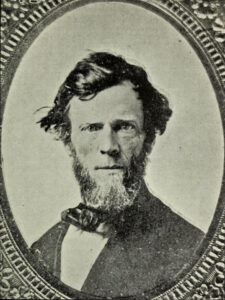 Ezekiel C. Hawkins (pdf). Ezekiel Cooper Hawkins opened the first daguerreotype studio in Greater Cincinnati in 1841. Hawkins learned about the daguerreotype process by corresponding with Samuel Morse who is known as the “father” of American photography. An artist and technical innovator, Hawkins’ daguerreotypes are found in archives throughout North America. Photo: Portrait of Ezekiel Hawkins, “The Pathfinders of Jefferson County,” W.H. Hunter, Steubenville Gazette, published in The Ohio Archaeological and Historical Quarterly, Vol. 6, 1898, Alamy.
Ezekiel C. Hawkins (pdf). Ezekiel Cooper Hawkins opened the first daguerreotype studio in Greater Cincinnati in 1841. Hawkins learned about the daguerreotype process by corresponding with Samuel Morse who is known as the “father” of American photography. An artist and technical innovator, Hawkins’ daguerreotypes are found in archives throughout North America. Photo: Portrait of Ezekiel Hawkins, “The Pathfinders of Jefferson County,” W.H. Hunter, Steubenville Gazette, published in The Ohio Archaeological and Historical Quarterly, Vol. 6, 1898, Alamy.
Charles Fontayne and William Porter (pdf). Charles Fontayne and William Porter are best known for their masterpiece, Daguerreotype View of Cincinnati, 1848, an eight-plate panorama that captures a mile long stretch of the riverfront of Cincinnati. Individually, Fontayne and Porter made substantial contributions to the development of early American photography. Photo: Portrait of William S. Porter, full-plate daguerreotype, undated, Cincinnati Public Library. There is no known image of Charles Fontayne.
James Presley Ball (profile in progress)
Charles Waldack (pdf). Charles Francois Auguste Waldack was an internationally-recognized photographer who operated a successful photographic studio in Cincinnati from about 1857 to 1882. Waldack is best known as the first person to photograph a cave system in America. In 1866, Waldack’s photographs stunned the world when published in the stereographic card series, Magnesium Light Views in Mammoth Cave. Photo: Portrait of Charles Waldack, cabinet card, date unknown, by Charles Waldack, Gand (Ghent) Belgium, National Cave Museum.
Future Episodes:
The Big Picture: A History of Photography in Greater Cincinnati is planned as a three-hour series covering a century of our region’s photographic heritage from 1839 to 1869. Pending funding, Voyageur’s future episodes in the series are:
Episode Two: “Developing Communities” (1870 – 1909)
“Developing Communities” examines the social, economic and cultural influence of photography in the daily life of families and communities. We explore how photographs became an essential instrument for governments, business and advertising. During this period, photography was increasingly used to document special events for families, academic institutions, and religious organizations. Photographers captured civic and cultural events, including business expositions, architecture, art, social clubs, sports teams, and entertainment. Photography and lantern slides, a new projection technology, served as an effective tool for social movements addressing health, sanitation, education, poverty and child labor laws. The second episode also explores the rise of amateur photography as cheaper cameras and film allowed more citizens to capture life.
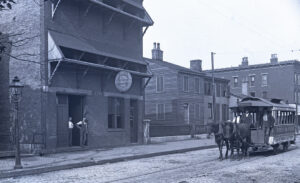 Louis Rombache and Theadore Groene were two of the most prolific and successful commercial photographers in Greater Cincinnati at the turn-of-the century. Rombache and Groene learned their trade while working in the studios of Charles Waldach and Charles Muhrman. In 1883, the two men established Mercantile and Landscape Photographers, a studio that documented the architecture, people and events in our region for almost a century. Image: The Last Horse Car, c1892, Rombach and Groene Rombach & Groene Collection, Cincinnati Museum Center.
Louis Rombache and Theadore Groene were two of the most prolific and successful commercial photographers in Greater Cincinnati at the turn-of-the century. Rombache and Groene learned their trade while working in the studios of Charles Waldach and Charles Muhrman. In 1883, the two men established Mercantile and Landscape Photographers, a studio that documented the architecture, people and events in our region for almost a century. Image: The Last Horse Car, c1892, Rombach and Groene Rombach & Groene Collection, Cincinnati Museum Center.
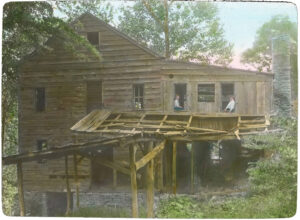 Elmer L. Foote served as the official photographer for the Cincinnati Public Library from 1900 until his death in 1919. He also contributed photographs to the Cincinnati Commercial Tribune. Foote took hundreds of photographs and lantern slides of everyday life and historic sites throughout Greater Cincinnati, as well as communities in the eastern Appalachian regions of Kentucky. Image (colored lantern slide): The Findlay Mill at Muddy Creek, (aka Kuehn’s Mill located near Devil’s Backbone Road,) c1900s, Elmer Foote, Cincinnati Public Library.
Elmer L. Foote served as the official photographer for the Cincinnati Public Library from 1900 until his death in 1919. He also contributed photographs to the Cincinnati Commercial Tribune. Foote took hundreds of photographs and lantern slides of everyday life and historic sites throughout Greater Cincinnati, as well as communities in the eastern Appalachian regions of Kentucky. Image (colored lantern slide): The Findlay Mill at Muddy Creek, (aka Kuehn’s Mill located near Devil’s Backbone Road,) c1900s, Elmer Foote, Cincinnati Public Library.
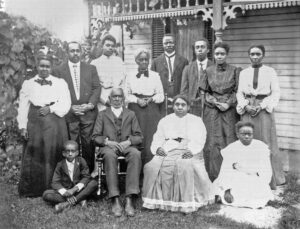 Frank R. Snyder had a distinguished career as a professional photographer based in Oxford, Ohio. Over a period of five decades (1897 – 1955), Snyder photographed campus life, students and events for Miami University. He also photographed families and rural life in Butler County. Snyder’s remarkable collection of over 4000 photographs is archived by The Lane Libraries and Miami University. Image: The Hastings family, 1905, Frank Snyder, Walter Havighurst Special Collections, University Archives & Preservation, Miami University.
Frank R. Snyder had a distinguished career as a professional photographer based in Oxford, Ohio. Over a period of five decades (1897 – 1955), Snyder photographed campus life, students and events for Miami University. He also photographed families and rural life in Butler County. Snyder’s remarkable collection of over 4000 photographs is archived by The Lane Libraries and Miami University. Image: The Hastings family, 1905, Frank Snyder, Walter Havighurst Special Collections, University Archives & Preservation, Miami University.
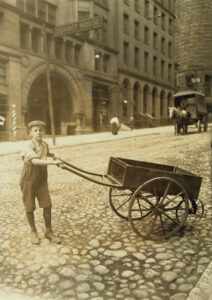 Lewis Wickes Hine was a renowned social activist and photographer when he traveled across America to document labor conditions for the National Child Labor Committee from 1908 to 1911. Hine took 34 photographs of children and adults at work on the streets of Cincinnati in 1908. When published, his photojournalism shocked the nation, leading to stronger labor laws. Image: Geo. Rabholz, 14 years old, 724 Main St., Cincinnati, Ohio, delivers bundles for a printing office. Aug. 1908., Lewis Wickes Hine, National Child Labor Committee collection, Library of Congress.
Lewis Wickes Hine was a renowned social activist and photographer when he traveled across America to document labor conditions for the National Child Labor Committee from 1908 to 1911. Hine took 34 photographs of children and adults at work on the streets of Cincinnati in 1908. When published, his photojournalism shocked the nation, leading to stronger labor laws. Image: Geo. Rabholz, 14 years old, 724 Main St., Cincinnati, Ohio, delivers bundles for a printing office. Aug. 1908., Lewis Wickes Hine, National Child Labor Committee collection, Library of Congress.
Episode Three: “Expanding Views” (1910 – 1939)
“Expanding Views” follows the growth of photography into a conventional tool for business, communications and education. This episode explores how photographers covered special occasions, historical events and everyday life. We feature regional photographers who used photography in science, for social reforms and as high art. The episode concludes with a look at contemporary issues facing curators who are working to conserve, catalogue and make accessible the millions of photographs preserved in their archives.
Felix John Koch photographed thousands of people and places throughout the region from 1906 to 1933. Koch worked as a writer for three local newspapers before launching a successful career as a freelance writer and photographer. He contributed articles and images to regional publications, as well as national magazines such as National Geographic. Koch covered Cincinnati for the War Department during World War I, and he traveled worldwide to document historic events. The Cincinnati Museum Center holds over 10,000 prints and negatives in the Felix J. Koch Collection. Image: Vendors at Jabezz Elliott Flower Market, Cincinnati, 1900s, by Felix Koch, Cincinnati Museum Center/Getty Images.
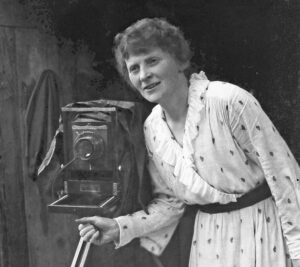 Nancy Ford Cones rose from amateur competitions to become a nationally recognized professional photographer. Cones and her husband, James, established a studio at their farm in Loveland, Ohio in 1905. She is best known for her innovative use of natural light to create formal portraits, pictorial scenes of rural life, and images inspired by historic literature. Cones’ photographs were used in advertising and published in magazines, including National Geographic and Camera Craft. Scholars and private collectors honored her work in the exhibit, “Camera and Craft: The Art of Nancy Ford Cones,” shown at the Taft Museum of Art in 2022. Image: Nancy Ford Cones, 1930s, Loveland Museum Center.
Nancy Ford Cones rose from amateur competitions to become a nationally recognized professional photographer. Cones and her husband, James, established a studio at their farm in Loveland, Ohio in 1905. She is best known for her innovative use of natural light to create formal portraits, pictorial scenes of rural life, and images inspired by historic literature. Cones’ photographs were used in advertising and published in magazines, including National Geographic and Camera Craft. Scholars and private collectors honored her work in the exhibit, “Camera and Craft: The Art of Nancy Ford Cones,” shown at the Taft Museum of Art in 2022. Image: Nancy Ford Cones, 1930s, Loveland Museum Center.
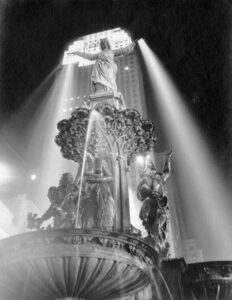 Paul Auguste Briol is well-known among photographers in Greater Cincinnati for his remarkable body of work from the 1920s to the 1950s. His black and white photographs of regional landmarks, shot with an 8 x 10” wooden view camera, are iconic in their artistic expression. Briol published several books, including The City of Rivers and Hills, 1925. The Paul Briol Photography Society at The Mercantile Library, an association of amateur and professional photographers, is named in his honor. Image: View of The Genius of Water, 1940s, Paul Briol, Cincinnati Museum Center/Getty Images.
Paul Auguste Briol is well-known among photographers in Greater Cincinnati for his remarkable body of work from the 1920s to the 1950s. His black and white photographs of regional landmarks, shot with an 8 x 10” wooden view camera, are iconic in their artistic expression. Briol published several books, including The City of Rivers and Hills, 1925. The Paul Briol Photography Society at The Mercantile Library, an association of amateur and professional photographers, is named in his honor. Image: View of The Genius of Water, 1940s, Paul Briol, Cincinnati Museum Center/Getty Images.
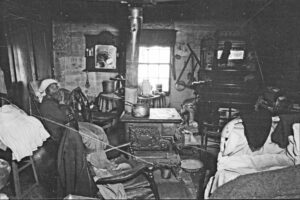 During the Great Depression, Russell Lee and Carl Mydans came to Cincinnati to document living conditions and federal programs created by President Roosevelt’s under his New Deal legislation. The Farm Security Administration hired photographs to document its programs across America. Lee and Mydans photographed federal projects in Greater Cincinnati, including Columbia Parkway, Laurel Homes, Greenhills, water works, sewers, parks, and murals. Image: Black Dwelling, Cincinnati, 1935, Carl Mydans, Farm Security Administration collection, Library of Congress.
During the Great Depression, Russell Lee and Carl Mydans came to Cincinnati to document living conditions and federal programs created by President Roosevelt’s under his New Deal legislation. The Farm Security Administration hired photographs to document its programs across America. Lee and Mydans photographed federal projects in Greater Cincinnati, including Columbia Parkway, Laurel Homes, Greenhills, water works, sewers, parks, and murals. Image: Black Dwelling, Cincinnati, 1935, Carl Mydans, Farm Security Administration collection, Library of Congress.

